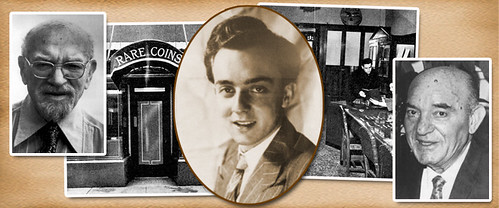
PREV ARTICLE
NEXT ARTICLE
FULL ISSUE
PREV FULL ISSUE
HARVEY STACK'S NUMISMATIC FAMILY, PART 34Harvey Stack's blog series focuses on living in a numismatic family. Here is part 34. Thanks, Harvey! -Editor  George Walton's collection was amassed during his travels mostly through the Mid-Atlantic States. He was an appraiser for banks and estates, and he traveled over a large area, meeting bank officers and collectors, private people who had coins for sale that were unknown to the general market. George died in an automobile accident in the Carolinas in 1962. He generally carried parts of his collection in his car to show to clients he developed along the way, or to make dramatic displays at coin shows or conventions. He also had an unbelievable quantity of duplicates and was always able to do business as he traveled about. The Stack family had met George in about 1937, and saw him regularly as he visited New York about three or four times a year. He bought and sold from Stack's, as well as other dealers. I can't remember the exact count but I know that George owned over 500 gold coins produced by the Bechtler family in all denominations and styles. He had a like quantity of Charlotte and Dahlonega mint coins. He loved private and territorial gold coins and also had a vast collection of such coins made in California, Oregon, Colorado and Utah. He had a great affection for $50 gold "slugs," both octagonal and round. He rarely sold any of these as he had a competitive spirit and loved to show quantities at National Coin Shows. He and Amon Carter, Jr. used to show off their accumulations. I remember at one show in the 1950s Walton and Carter each displayed most of their $50 gold pieces. I was amazed that together they had on display at one time 101 pieces, 50 belonging to Amon Carter and 51 to George Walton. This was a dazzling display for sure, like seeing a Wells Fargo Chest of yesteryear. Carter said, "I could have brought more!” And Walton responded, “I could have brought more also!” They both laughed and went to the bar to have a drink together. In those days collectors carried lots of coins to a show, competed with each other, were great friends and made collecting, trading, buying and selling, and learning from each other really fun. Back now to George Walton. After the fatal crash, thousands of coins were scattered all over the highway. The police roped off the area and placed several guards along the highway while other officers searched the highway and the surrounding area for items that belong to George. After several days of searching the coins found were turned over to the Walton family. What they did not find was Walton's 1913 Liberty Head nickel, a great rarity. Another search followed and all that was found was a 1913 (altered date) Liberty Head nickel. Walton had planned to display the 1913 at a show he was attending that night, but probably took the replica rather than the original. The original was found by the family at his home decades later and thereafter was sold. However, as the real nickel was not found at the time, it was not included in Stack's offering of Mr. Walton's coins in 1963. The first portion of the Walton sale took place in June 1963 and offered lower grade gold, silver and copper coins, 2164 lots, with many single coins and group lots. The second portion of the George Walton took place in October 1963 and contained an additional 3,400 lots! The total of the two sales were 5,564 lots! This became one of the largest sales conducted in the decade. The fact that it contained so many duplicates allowed many collectors to get coins for their collections and dealers could enhance their stocks. We were even able to list and describe 27 different varieties of the Bechtler family coins. Stack's numbered each described variety with "S" numbers, and the design differences were fully illustrated and listed in the Guide Book of the following year. This required working a good number of evenings with my cousin, Norman, reviewing each coin to assign it a variety. Collectors, especially those who specialized in Southern gold coins, used the catalog to help them acquire these series in depth. In addition to coins, Walton had an extensive collection of Southern paper currency, from broken bank notes to federal issues, which he also was able to acquire during his constant travels, in the same way he purchased coins. The Walton Collection provided private and territorial coins to the Josiah K. Lilly Collection, as well as items for the Conrad Bolt Collection. Dr. Bolt was able to complete his collection from the Walton sales, and in 1966 Stack's was chosen to sell that collection. With the sales of the Samuel Wolfson Collection and the George Walton Collection in 1963, as well as an influx of buyers, Stack's had a major year of growth. Of course, difficulties still remained in the numismatic hobby, mostly the attempts to enforce the new Gold Import Act, that made us quite dependent on what could be found in the American marketplace. This was true of across the entire market, and there was a lot of competition for numismatic items that were not subject to the import regulations. This pressure by the Treasury Department made the coins that were available more costly, and prices, especially of gold coins continued to rise. To read the complete article, see: To read the earlier E-Sylum article, see:  Wayne Homren, Editor The Numismatic Bibliomania Society is a non-profit organization promoting numismatic literature. See our web site at coinbooks.org. To submit items for publication in The E-Sylum, write to the Editor at this address: whomren@gmail.com To subscribe go to: https://my.binhost.com/lists/listinfo/esylum All Rights Reserved. NBS Home Page Contact the NBS webmaster 
|